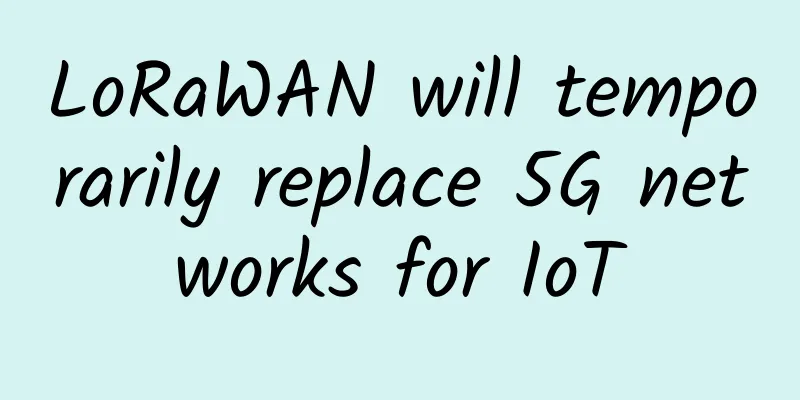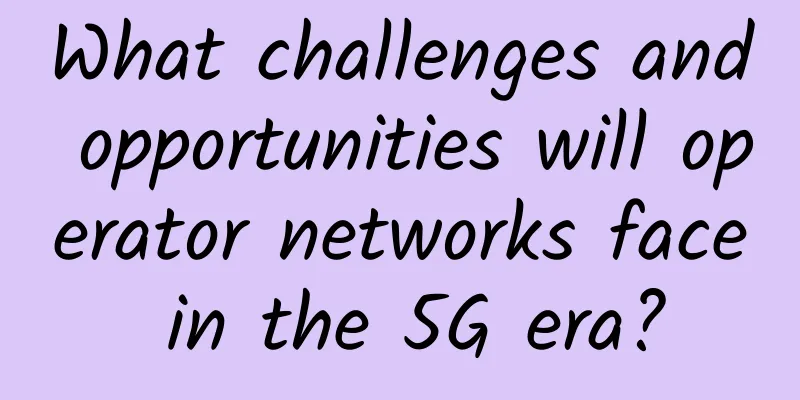LoRaWAN will temporarily replace 5G networks for IoT

|
5G networks are set to revolutionize the Internet of Things (IoT). But it will take a few years for the technology to cover most of the planet. Thanks to LoRaWAN, you don’t have to wait. According to Gartner, enterprise and automotive IoT endpoints will be in use throughout 2020, reaching approximately 5.8 billion, up 21% from 2019. Telecommunications networks will soon have a hard time handling this load.
IoT experts are pinning their hopes on 5G as the future IoT connectivity standard that will replace physical networks and enable real-time responses. The key word here is "future." Ericsson predicts that by 2025, 5G technology will only cover two-thirds of the world's population. With all the hype surrounding 5G, people often overlook an alternative that has been around for five years: Low Range Wide Area Network (LoRaWAN). In many cases, LoRaWAN could replace 5G, at least until 5G becomes available around the world. Why is 5G technology attracting so much attention? What challenges does it face? 5G technology has attracted much attention for its unprecedented speed and signal quality. It will enable connected devices to exchange data 50% faster and in larger blocks, and is expected to achieve breakthrough progress in all industries. In healthcare, 5G will enable robotic surgery by providing high-quality video streaming and connected surgical devices with instant responses. Emergency services will use 5G to respond to situations immediately. City cameras and camera-equipped drones will be able to identify emergencies and send information about them to a control room within seconds. 5G technology will also enable more industry employees to work from home than during the pandemic. They will be able to manage their equipment remotely via a PC, tablet or smartphone. This could be a further boost for the oil and gas industry, whose facilities are often located in adverse terrain. Finally, driverless cars are essential to 5G networks. It enables them to connect to city infrastructure and adjust travel conditions in real time. This technology will unleash the power of smart cities, where everything is connected and operated through artificial intelligence. 5G Challenges To establish a 5G network in an area, you need to build a specific infrastructure from scratch. Although 5G precedes 4G, it requires different antennas, a new structural network, and additional towers. Building this infrastructure is a long process, and an expensive one too: The European Commission estimates that introducing 5G in every town and city in Europe would cost €500 billion. In addition, consumers and manufacturers have not been particularly enthusiastic about 5G technology so far. According to a recent GSMA survey, only about 30% of Americans and 11% to 23% of Europeans said they would get a 5G phone once the technology is available. Which of the following is "more important" to your company's recovery? Source: Technology priorities for businesses in the post-pandemic era As a result, 5G adoption remains slow. LoRaWAN as an alternative to 5G LoRa/LoRaWAN can do most of the things that 5G can do - just more slowly and at a lower cost. You're unlikely to use LoRa to transmit video and sound. LoRa's speeds range from 0.3Kbps to 27Kbps, which means it would take hours to transmit an image and decades to stream a movie. However, LoRa is great for many other uses. This technology was originally developed for industrial IoT sensors, not consumer devices. It is used to transmit short data packets (about 240 bytes) and does not support network IP stacks. This makes LoRa suitable for transmitting temperature, humidity, vibration, lighting and similar data. LoRa and LoRaWAN stand for Long Range Protocol and Long Range Wide Area Network. They are based on Low Power Wide Area Network technology LPWAN. In this post, I won’t go into too much detail about how LoRa and LoRaWAN work and how they relate to each other. Instead, let’s look at what makes them viable alternatives to 5G technology. Why LoRa is important LPWAN-powered devices can communicate over long distances, even if each device is in a separate building. In addition, their batteries last longer than those of devices using 4G and 5G. A LoRa-based device can work for 10 years on a single battery, while a 5G device can only last a few hours. LoRaWAN network coverage Source: LoRaWAN global coverage as of December 2018 Unlike 5G networks, LPWAN does not require a huge infrastructure. It runs on small, inexpensive devices, even cheaper than 4G. LoRa sensors cost between $0.2 and $0.5, while 5G sensors start at $30. By comparison, a typical LoRa base station costs about $40 and can handle thousands of connections over a 15-kilometer range. A 5G base station costs $60,000, covers 2 kilometers, and can handle about 1,000 connections. Since the birth of LoRaWAN in 2015, a wide variety of LoRaWAN sensors and devices have been developed. The non-profit association of companies using this technology, the LoRaAlliance, has grown to more than 500 members. Here are some eye-catching statistics from the alliance:
Non-cellular LPWA connections by smart meter type Source: ABI Research How to use LoRa Using LoRa, IoT can be applied in multiple fields. These may include vending machines, hotel infrastructure, agricultural equipment, hospitality facilities and even the management of smart cities. In 2016, Samsung, Semtech, and SK Telecom teamed up to build the world’s first nationwide LoRaWAN in South Korea. Today, Seoul is planning to upgrade its local LoRa-based IoT infrastructure. The Seoul Smart Network, or S-Net as it’s known, will have up to 1,000 LoRaWAN gateways by 2022. They’ll enable smart parking lots, street lights that can alert police in emergencies, monitoring systems for dementia patients, and more. The Future of LoRa In 2019, UK-based IoT satellite provider LacunaSpace began covering the globe with LoRaWAN. In July 2020, the company’s CTO said that LacunaSpace was “receiving LoRaWAN messages from a sailboat that is literally in the middle of the Atlantic.” A global LoRa network will incentivize developers to build more LoRa-powered applications, which will help protect the future of the technology. Therefore, if you are in the IoT business, I would recommend using LoRa/LoRaWAN until 5G technology becomes more common. Even if that happens, I suspect LoRa may still be the telecom technology of choice for many businesses. What about NB-IoT? Some devices using LoRa have also been connected to narrowband IoT (NB-IoT) networks. NB-IoT is a LPWAN standard developed by the same organization that developed the 4G and 5G protocols. In other words, it's a cellular technology that:
As a cellular technology, it also has higher bandwidth than LoRa. NBIoT does not require building a specific infrastructure: it only requires software. Therefore, this type of network can be easily expanded to cover millions of devices. However, the number of such devices is still far less than the number of LoRa devices. In terms of weaknesses, the main issue is that NB-IoT draws a lot of power, so device batteries drain very quickly. NB-IoT also requires high security. LoRaWAN uses end-to-end encryption, which is a modern security standard mechanism, while NB-IoT relies on hop-by-hop encryption, which is becoming increasingly outdated. That’s why I think LoRa is a better alternative to 5G than NB-IoT. in conclusion After reading this article, you should have a better practical understanding of the major recent telecommunication technologies: 5G and LoRa. You might have the impression that there will be a market competition between the two technologies and LoRa will lose and become history. Yes, they may compete in certain market segments, which is good for the industry as it will help it grow. But I don’t believe 5G will kick LoRa out of the game. After all, cars did not replace bicycles and trains. |
>>: Unleash the power of 5G! H3C launches MSR series 5G routers
Recommend
When is the right time to buy Wi-Fi 6E?
Despite the indisputable advantages of operating ...
How to truly experience 1G internet speed in the 5G era? WiFi has become an important help!
According to statistics, 20% of the sites in hots...
[11.11] DogYun: 30% off on Elastic Cloud, 20% off on Classic Cloud, 100 yuan off on Dedicated Server/month, 1 yuan free for every 11 yuan spent
DogYun has just released its promotional plan for...
Here is a list of RackNerd's cheap promotional packages, starting from $9.89 per year
RackNerd has a certain position among low-cost VP...
A complete history of web crawlers
[[415987]] The well-known research organization A...
Application of load balancing technology in computing power network
Part 01, ECMP ECMP is a hop-by-hop, flow-based lo...
AvenaCloud: €11.5/year - 1GB/10GB SSD/100M unlimited traffic/Moldova complaint-resistant VPS
AvenaCloud is a Moldovan hosting company establis...
Experience the Serverless application programming model in cloud native scenarios
background Alibaba Cloud Serverless Kubernetes (A...
Is your business Wi-Fi fast enough?
Whether you are trying to troubleshoot a problem,...
New infrastructure, new engine: Huawei releases new generation NetEngine 8000 full-service smart router
[Nanjing, China, August 18, 2020] Today, at a pre...
Global 5G users will reach 3.5 billion by 2026
Globally, more than 1 billion people, or 15% of t...
Three major trends in digital transformation in 2018, blockchain will usher in spring
In 2017, which is about to pass, digital transfor...
How to identify the protocol of an unfamiliar CAN network?
In a CAN network, all nodes share a bus for data ...
Very comprehensive! A comparison of the financial and operating data of the three major operators in the first quarter
Recently, the three major operators have announce...
Yike Cloud: 20% off on all VPS hosts, US CN2 GIA/AS9929/AS4837/Hong Kong CN2, etc. starting from 22 yuan/month
OneTechCloud is a Chinese hosting company founded...









![[11.11] iOVZ: 60% off monthly payment/50% off annual payment for all VPS/dedicated servers, Hong Kong/Korea VPS monthly payment starts from 36 yuan](/upload/images/67cabd2aaf03f.webp)